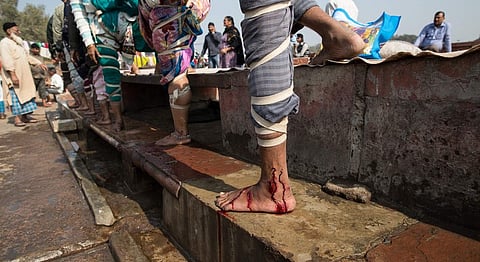
- HOMEGROWN WORLD
- #HGCREATORS
- #HGEXPLORE
- #HGVOICES
- #HGSHOP
- CAREERS
- ABOUT US
- CONTACT US

In a country that is fragmented with different traditions- there is an invariable existence of diversity. And this diversity lives within all the tiny boxes of society, linking itself to the arts, sciences, medicine, commerce, politics etc.
In this new segment, we delve into the specifics of medicinal practitioners in the country; procuring a deep insight into some of their strange practices and familiarizing ourselves with their alien ways. And today, we’re all about India’s Bloodletters.
If you were to see a man sculpting his way through a patient’s vein with a razor, would you believe that was the godsend panacea for his ailing condition? Corresponding to how graphic it sounds, the process of Bloodletting is probably one of the most explicitly gory practices you’ll ever see.
The ancient process dates back to the early civilizations, often being cited in several historic Ayurvedic texts. One of the oldest techniques, the practice includes the withdrawal of often-small quantities of blood from a patient to cure or prevent illness and disease. The system is based on primal medicine that regarded blood and other bodily fluids as “humors” that had to remain in proper balance to maintain health.
The process of controlled bleeding is recommended by these practitioners who believe it is essential for the body to get rid of “polluted blood” in order to heal from any kind of condition, be it arthritis or heart problems. Naturally, the 79 year old Mohammad Ghyas, a practitioner in Delhi, meets hundreds of impoverished patients daily, who come to him to be healed from all their aches and pains.
“If a patient is brought to the clinic at the early stages, it can even cure blood cancer.” –Mohammad Ghyas
Not only have a large amount of locals shunned modern medicine for this alternative, the practice has attracted people from all over the globe, as far as the U.S and Japan.
This ancient practice of venesection has been disseminated from generation to generation, equipping every new practitioner with the correct know-how to conduct such methods safely. Gyas was trained by his grandfather and has passed his knowledge on to his son, who currently runs the practice. A sufferer of Parkinson’s disease, Gyas stopped practicing bloodletting since 2008, although he’s overseen every treatment every day since 1980. As you can imagine, none of these men are licensed doctors. But that hasn’t deterred patients from signing up, who voluntarily allowed the practioners to make incisions in their veins.
The patients who receive this treatment tend to belong to low economic profiles, who are incapable of sourcing other forms of treatment. Gyas says that he does not charge patients, most of who are poor. However they pay about 40 rupees to his assistants for their work – about 10 times less than what even homeopaths, popular alternatives in India to GPs, charge for a consultation.
“When people come to me, they have very little money. What can I take from such people?”
Acknowledging that they are not like “commercial doctors”, these practitioners claim that they work for the patient’s well-being, over anything else. Although this therapy has reaped a fair amount of followers, there are a large amount of conventional doctors who dismiss it as fraud.
“Diabetes has to be controlled from day one, what has happened is that many people, especially uneducated and poor people, go to such quacks, take treatments which obviously do not work,” said Diabetes specialist Rajesh Keswar.
According to a 2013 Oxfam report, the Indian public health system still falls short of meeting the needs of its 1.2 billion people. However, what’s interesting is most of the poor people do not resort to the option of bloodletting as an option to work within their means, but rather choose it willingly, over other traditional methods of surgery much to such professional doctors’ chagrin.
“Earlier, I was unable to sit or stand,” said Jayant Kumar, 42, who was left physically disabled by a road accident four years ago. “Now I can even walk without any support.”
When Gyas is questioned about his methods working, he talks about the copious amount of blades he has used on his patients since 1980.
“This many years, this many people, this many blades. How could you doubt my treatment working?”
WORDS: SHREYA VAIDYA
PICTURES: www.sbs.com.au
